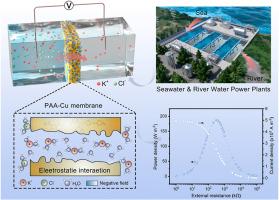High-performance ionic covalently modified polyamide acid membrane for osmotic energy conversion
IF 9
1区 工程技术
Q1 ENGINEERING, CHEMICAL
引用次数: 0
Abstract
Nanofluidic membranes exhibit considerable promise for osmotic energy harvesting. However, a persistent challenge lies in engineering porous structures that simultaneously facilitate rapid, high-flux ion transport while maintaining high selectivity and robust mechanical strength. Herein, we introduce a strategy that leverages the coordination interaction between Cu2+ ions and the carboxyl groups on polyamide acid (PAA) molecular chains to transform an initially dense PAA membrane into one with a uniform nanoporous architecture. The resultant PAA-Cu composite membrane achieves an exceptionally high-power density of 187 W/m2 in osmosis energy conversion tests with a 50-fold KCl concentration gradient (0.5 M/0.01 M), a performance that substantially surpasses other state-of-the-art materials. This superior performance is attributed to the nanoporous network created by copper ion coordination, which concurrently maintains high ion selectivity while significantly enhancing the overall ion transport flux. Notably, the PAA-Cu membrane was fabricated at a large scale (up to 390 cm2) and exhibited a high tensile strength of 83 MPa, demonstrating the mechanical robustness required for practical applications. This strategy of synergistically optimizing the membrane's pore structure and surface chemistry through metal coordination offers a promising new avenue for designing next-generation nanofluidic membranes for osmotic energy harvesting.

用于渗透能转换的高性能离子共价改性聚酰胺酸膜
纳米流体膜在渗透能量收集方面表现出相当大的前景。然而,一个持续的挑战在于工程多孔结构,同时促进快速,高通量的离子传输,同时保持高选择性和强大的机械强度。在此,我们引入了一种策略,利用Cu2+离子与聚酰胺(PAA)分子链上羧基之间的配位相互作用,将最初致密的PAA膜转变为具有均匀纳米孔结构的PAA膜。所得PAA-Cu复合膜在50倍KCl浓度梯度(0.5 M/0.01 M)的渗透能量转换测试中实现了187 W/m2的超高功率密度,其性能大大超过了其他最先进的材料。这种优异的性能归功于铜离子配位形成的纳米孔网络,它在保持高离子选择性的同时显著提高了整体离子传输通量。值得注意的是,PAA-Cu膜是在大规模(高达390 cm2)下制造的,并表现出83 MPa的高拉伸强度,证明了实际应用所需的机械坚固性。这种通过金属配位协同优化膜孔结构和表面化学的策略为设计用于渗透能量收集的下一代纳米流体膜提供了一条有希望的新途径。
本文章由计算机程序翻译,如有差异,请以英文原文为准。
求助全文
约1分钟内获得全文
求助全文
来源期刊

Journal of Membrane Science
工程技术-高分子科学
CiteScore
17.10
自引率
17.90%
发文量
1031
审稿时长
2.5 months
期刊介绍:
The Journal of Membrane Science is a publication that focuses on membrane systems and is aimed at academic and industrial chemists, chemical engineers, materials scientists, and membranologists. It publishes original research and reviews on various aspects of membrane transport, membrane formation/structure, fouling, module/process design, and processes/applications. The journal primarily focuses on the structure, function, and performance of non-biological membranes but also includes papers that relate to biological membranes. The Journal of Membrane Science publishes Full Text Papers, State-of-the-Art Reviews, Letters to the Editor, and Perspectives.
 求助内容:
求助内容: 应助结果提醒方式:
应助结果提醒方式:


